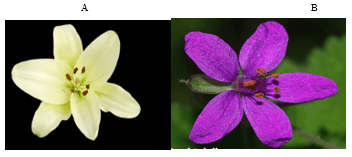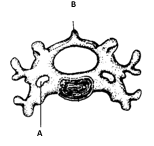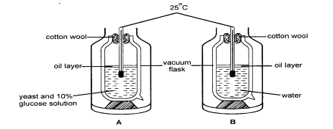Instructions
- Answer all the questions

QUESTIONS
- One of the function of the nucleus is storage of hereditary material also known as gene.
- What is a gene. (1mks)
- State the three functions of DNA. (3mks)
- State any two species of schistosoma that transmit bilharzia. (2mks)
-
- State three importance of photosynthesis in nature. (3mks)
- How does nutrition differ in plants and animals? (1mk)
-
- Identify the organelle shown below (1mk)

- How is the organelle you have identified in (a) above suited to its function? (2mks)
- Identify the organelle shown below (1mk)
- During a practical class, form four students estimated the field of view to be 3.5mm. Using the low power objective, they observed spirogyra cells across the same field of view and counted 8cells. Calculate the size of each cell and give your answer in micrometer. (3mks)
-
- Explain what happens when a wilting plant is watered. (2 marks)
- The diagram below represents a type of neurone

-
- identify the neuron above
- Give a reason for your answer in a(i) above
- With an arrow, indicate on the diagram the direction of an impulse transmission through the neuron
- Name the chemical substance that brings about transmission of impulse across a synapse
-
- The diagram below represents a mammalian jaw

- State the mode of feeding for the mammal. (1 mark)
- Describe three adaptations for this mammal from jaw to its mode of feeding. (3 marks)
- Where are the following structures found along the mammalian digestive tract? (2 marks)
- Pyloric sphincter
- Crypt of Lieberkuhn
- Explain how crops grown along roads can be a source of lead poisoning to human beings. (2 marks)
-
- State the characteristics that can separate the following organisms into respective classes; millipedes, tsetsefly and spider. (3marks)
- State the kingdom whose members have a cell wall made up of mullein. (1 mark)
- The diagrams below show organs obtained from members of Angiospermatophyta

To which classes do the plants from which the organs were obtained belong? (2marks)
A
B- Small insect-eating birds are feeding on the caterpillars and caterpilars are eating the leaves of a tree. A pair of sparrow hawks is hunting for small birds to feed their young.
- Represent the information on a food chain. (1 mark)
- Draw a pyramid of numbers of the above chain. Give the organisms at each trophic level (2marks)
- Small insect-eating birds are feeding on the caterpillars and caterpilars are eating the leaves of a tree. A pair of sparrow hawks is hunting for small birds to feed their young.
- Give two ways by which prey are adapted to escaping predators ( 2masrks)
- The diagram below shows the site where exchange of substances takes place in the mammalian circulation.

- Name the vessel labelled T [1mark]
- Name the fluid labelled F and state its importance [2marks]
- Explain the mechanism of formation of the liquid named in (b) above [3marks]
- Briefly give clear explanations to the statements below. [2 marks]
- In mammals haemoglobin is confined to erythrocytes. Give one advantages of this
- People living in high altitude areas have a higher erythrocyte count and more haemoglobin than people living in low altitudes. Suggest a reason for this adaptations
- Color blindness is a sex-linked trait controlled by a recessive gene b if a mother is carrier and father is normal what is the chance that their son will be colour blind? Show your working. (4mks)
-
- State the role of a generative cell during fertilization in flowering plants. (2mks)
- State two differences between prophase and prophase I. (2mks)
- Using the named parts of a flower in the table below. State the differences between insect pollinated flower and wind pollinated flower. (3marks)
Part Insect pollinated Wind pollinated Pollen grain Stigma Anthers -
- Name the part of the eye in which the light sensitive cells are located. (1mark)
- List the two types of sensory cells found in the part named in (a) above (2 marks)
- State the function of conjunctiva. (1 mark)
- The diagram below shows the position of an image formed in a defective eye:-

- Name the defect (1 mark)
- How can the defect be corrected. (1 mark)
- Name the disorder characterized by the following. (2marks)
- Having extra somatic chromosome
- Missing one of the sex chromosome
- Study the figure below then answer questions that follow.

- Identify the bone on the diagram above. (1mk)
- Name the part labelled A and B. (2mks)
A
B
- Name the type of joints found in the following regions. (2 marks)
- The anterior end of atlas.
- The articulation of glenoid cavity and head of humerus bone.
- A boy who is learning how to swim in sea water accidentally drinks a lot of sea water. Explain the effect this will have on his kidneys. (3mks)
-
- Name the fluid that is produced by sebaceous glands. (1mk)
- State two functions of sweat on the human body. (2mks)
- Two flasks were set up as shown below.

- What is the aim of the investigation? (1mark)
- Explain why the vacuum flasks were used instead of conical flasks. (1mark)
- What is expected of the thermometer reading after 2 hours in A? (2marks)
- Explain what happens when there is oxygen debt in human muscles (3mks)

MARKING SCHEME
- One of the function of the nucleus is storage of hereditary material also known as gene.
- What is a gene. (1mks)
- genetic make-up of a living organism;(hereditary factor)
- State the three functions of DNA. (3mks)
- stores genetic information in coded form
- Transferes genetic information from parents-offspring's unchanged through replication
- Translate genetic information in characteristics through protein synthesis
- What is a gene. (1mks)
- State any two species of schistosoma that transmit bilharzia. (2mks)
- schistosoma mansoni
- schistosoma haematobum
- schistosoma japonicum
-
- State three importance of photosynthesis in nature. (3mks)
- photosynthesis converts radiant/solar energy into chemical energy used by living organisms
- it provides oxygen in atmosphere for all living organisms
- it maintains the balanced level of oxygen and carbon dioxide ecosytstem
- How does nutrition differ in plants and animals? (1mk)
- plants are autrotrophs while animals are heterotrophs
- State three importance of photosynthesis in nature. (3mks)
-
- Identify the organelle shown below (1mk)

- Mitochondrion; rei mitochondrioa
- How is the organelle you have identified in (a) above suited to its function? (2mks)
- has cristae which increase the surface area for attachment of respiratory enzymes
- has matrix which is fluid filled to provide medium for enzyme activities
- Identify the organelle shown below (1mk)
- During a practical class, form four students estimated the field of view to be 3.5mm. Using the low power objective, they observed spirogyra cells across the same field of view and counted 8cells. Calculate the size of each cell and give your answer in micrometer. (3mks)
- cell length=Diameter of the field of view/number of cells
1mm=1000 micrometer
3.5mm=?
3.5*1000=3500 micrometer
cell length=3500/8
=437.5μm
- cell length=Diameter of the field of view/number of cells
-
- Explain what happens when a wilting plant is watered. (2 marks)
- the plant cell sap gains water absorbed from the roots by osmosis; becomes turgid;
- Explain what happens when a wilting plant is watered. (2 marks)
- The diagram below represents a type of neurone

-
- identify the neuron above
- motor neuron
- Give a reason for your answer in a(i) above
- multipolar
- identify the neuron above
- With an arrow, indicate on the diagram the direction of an impulse transmission through the neuron
- Name the chemical substance that brings about transmission of impulse across a synapse
- Acetycholine
-
- The diagram below represents a mammalian jaw

- State the mode of feeding for the mammal. (1 mark)
- herbivorous
- Describe three adaptations for this mammal from jaw to its mode of feeding. (3 marks)
- has diastema for the frequent movement of the tongue when collecting vegetation
- have a long tongue foe cutting and turning grass
- no upper incisors/horny pad to press grass against it when cutting
- Where are the following structures found along the mammalian digestive tract? (2 marks)
- Pyloric sphincter
- end value of stomach
- Crypt of Lieberkuhn
- ileum
- Pyloric sphincter
- State the mode of feeding for the mammal. (1 mark)
- Explain how crops grown along roads can be a source of lead poisoning to human beings. (2 marks)
- crops absorb lead from car exhaust fuses; and pass it to animals and humans through/along the food chain
-
- State the characteristics that can separate the following organisms into respective classes; millipedes, tsetsefly and spider. (3marks)
- body parts
- number of limbs
- body segments
- State the kingdom whose members have a cell wall made up of mullein. (1 mark)
- State the characteristics that can separate the following organisms into respective classes; millipedes, tsetsefly and spider. (3marks)
- The diagrams below show organs obtained from members of Angiospermatophyta

To which classes do the plants from which the organs were obtained belong? (2marks)
A monocotyledonae
B dicotyledonae- Small insect-eating birds are feeding on the caterpillars and caterpilars are eating the leaves of a tree. A pair of sparrow hawks is hunting for small birds to feed their young.
- Represent the information on a food chain. (1 mark)
- Draw a pyramid of numbers of the above chain. Give the organisms at each trophic level (2marks)
- Small insect-eating birds are feeding on the caterpillars and caterpilars are eating the leaves of a tree. A pair of sparrow hawks is hunting for small birds to feed their young.
- Give two ways by which prey are adapted to escaping predators ( 2masrks)
- ability to run fas; agility
- camouflage
- staying and feeding in large numbers
- confrontational dislplay
- The diagram below shows the site where exchange of substances takes place in the mammalian circulation.

- Name the vessel labelled T [1mark]
- venule
- Name the fluid labelled F and state its importance [2marks]
- tissue fluid; forms medium through which exchange of materials between blood and tissue cells takes place
- Explain the mechanism of formation of the liquid named in (b) above [3marks]
- the pumping force from the heart together with the narrow lumens of capillary exert a high pressure; that farces the fluid part of the blood to filter out of the capillary walls into intercelluar space. this occurs by ultra filtration/pressure filtration
- Name the vessel labelled T [1mark]
- Briefly give clear explanations to the statements below. [2 marks]
- In mammals haemoglobin is confined to erythrocytes. Give one advantages of this
- if haemoglobin were dissolved in plasma, osmotic pressure of blood wouls increase considerably;(and this wouls interfere with other phycological processes)
- if haemoglobin were dissolved in plasma, the viscosity of the blood would increase considerably;(this would require he heart to work much harder to pump blood throughout the body)
- People living in high altitude areas have a higher erythrocyte count and more haemoglobin than people living in low altitudes. Suggest a reason for this adaptations
- at high atiude, the partial pressure/concentration of oxygen is low; the high erythrocyte count and the a large amount of haemoglobin enhances the oxygen carrying capacity of heir blood;(ensuring that blood takes up sufficient oxygen in the lungs in spite of low partial pressure)
- In mammals haemoglobin is confined to erythrocytes. Give one advantages of this
- Color blindness is a sex-linked trait controlled by a recessive gene b if a mother is carrier and father is normal what is the chance that their son will be colour blind? Show your working. (4mks)
- parenal phenotype Normal color vision man Normal colour vision woman
parental genotype XBY XBXb
gametes XB Y XBXb
F1 generational genotype XBXB XBXb XBY XbY
- parenal phenotype Normal color vision man Normal colour vision woman
-
- State the role of a generative cell during fertilization in flowering plants. (2mks)
- divides mioically to give rise o two male nuclei; one male gamete fuses with egg cell o form diploid zygote and the other fuses with polar nuclei to form primary endosperm
- State two differences between prophase and prophase I. (2mks)
- prophase I there is chiasmata formation
- prophases I homologous chromosmes forms a bivalent
- State the role of a generative cell during fertilization in flowering plants. (2mks)
- Using the named parts of a flower in the table below. State the differences between insect pollinated flower and wind pollinated flower. (3marks)
Part Insect pollinated Wind pollinated Pollen grain large, heavy and rough light Stigma sticky feather Anthers small and firmly attached to filament large and loosely attached -
- Name the part of the eye in which the light sensitive cells are located. (1mark)
- retina
- List the two types of sensory cells found in the part named in (a) above (2 marks)
- rods
- cones
- Name the part of the eye in which the light sensitive cells are located. (1mark)
- State the function of conjunctiva. (1 mark)
- protecs the front part of cornea
- The diagram below shows the position of an image formed in a defective eye:-

- Name the defect (1 mark)
- short-sightedness (myopia)
- How can the defect be corrected. (1 mark)
- by wearing concave (converging lenses)
- Name the defect (1 mark)
- Name the disorder characterized by the following. (2marks)
- Having extra somatic chromosome
- Down's syndrome
- Missing one of the sex chromosome
- Turner's syndrome
- Having extra somatic chromosome
- Study the figure below then answer questions that follow.

- Identify the bone on the diagram above. (1mk)
- cervical vertebra
- Name the part labelled A and B. (2mks)
A vertebraterial canal
B neural spine
- Identify the bone on the diagram above. (1mk)
- Name the type of joints found in the following regions. (2 marks)
- The anterior end of atlas.
- pivot joint/hinge joint
- The articulation of glenoid cavity and head of humerus bone.
- ball and socket
- The anterior end of atlas.
- A boy who is learning how to swim in sea water accidentally drinks a lot of sea water. Explain the effect this will have on his kidneys. (3mks)
- salt from sea water is absorbed into blood stream which rise the osmotic pressure above normal level
- the increase is deected by osmoreceptors in hypothalumus which in turnaend impulses to pituitary gland
- pituitary gland will produce more anidiurectic hormone
- antidiurectic hormone increase permeability of water which lowers the osmotic level
-
- Name the fluid that is produced by sebaceous glands. (1mk)
- sebum
- State two functions of sweat on the human body. (2mks)
- cools the body
- getting rid of waste/excretion/removal of lactic acid/removal of excess salts/removal of excess water
- Name the fluid that is produced by sebaceous glands. (1mk)
- Two flasks were set up as shown below.

- What is the aim of the investigation? (1mark)
- to investigate anaerobic respiration
- Explain why the vacuum flasks were used instead of conical flasks. (1mark)
- to conserve the heat energy tha is produced
- What is expected of the thermometer reading after 2 hours in A? (2marks)
- the temperature rise in the thermometer; as yeast cells respire using glucose to release heat energy that rises the temperature
- What is the aim of the investigation? (1mark)
- Explain what happens when there is oxygen debt in human muscles (3mks)
- muscles respire anaerobically, resulting in accumulation of lactic acid in the tissues, causing fatigue/muscle crumps; the rate of breathing and heartbeat increases; toxic lactic acid is broken down into carbon (IV) oxide and energy in the muscle or transported to liver and converted to glycogen for storage
Join our whatsapp group for latest updates
Tap Here to Download for 50/-
Get on WhatsApp for 50/-
Download Biology Paper 1 Questions and Answers - Kassu Jet Joint Mock Exams 2023.
Tap Here to Download for 50/-
Get on WhatsApp for 50/-
Why download?
- ✔ To read offline at any time.
- ✔ To Print at your convenience
- ✔ Share Easily with Friends / Students
